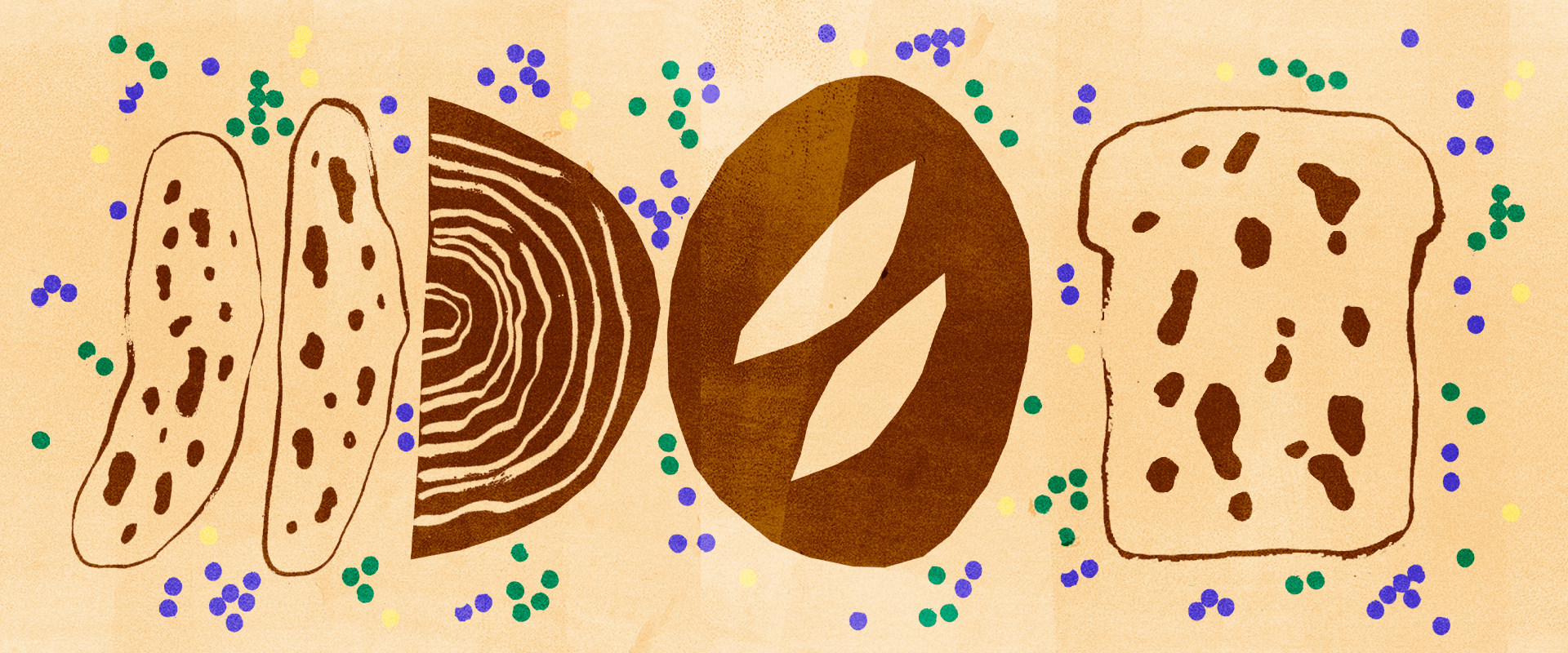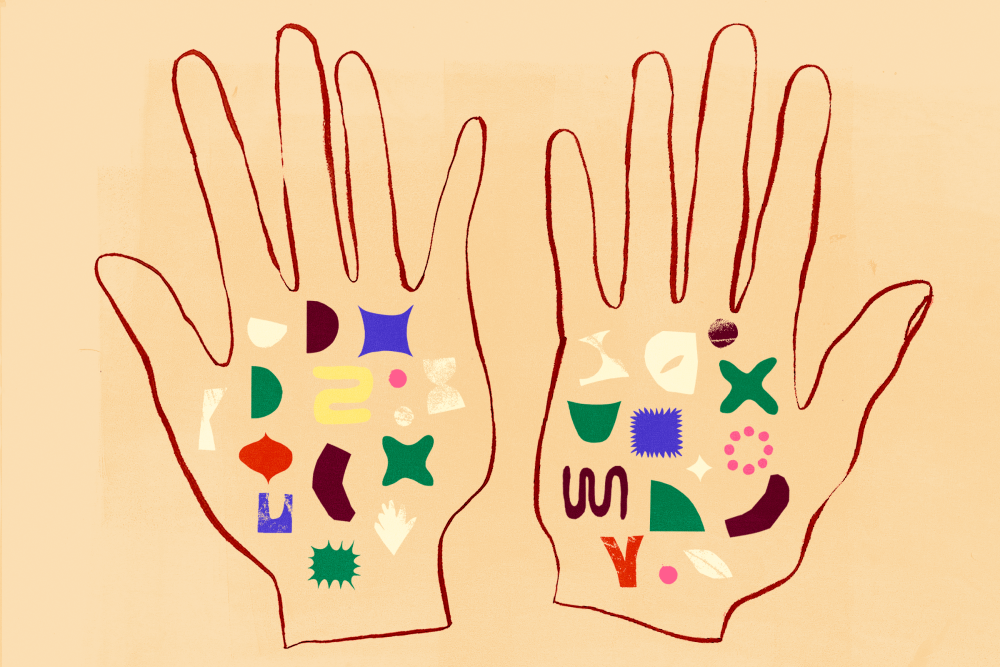Words Charlie Monaghan
Illustrations Jordan Amy Lee
Have you ever wondered why sourdough bread is tastier, has a better texture and is generally all the more satisfying to eat than a slice of commercial white bread? The answer? Well, there’s more than one, but the main differentiator is the strange and wonderful alchemy of fermentation. Here to explain what it is – and isn’t – is our master baker, Anomarel Ogen, with seven things that may recalibrate what you thought you knew about this much-buzzed-about but little-understood microbial process.
Humans have been fermenting foods for almost as long as we’ve been eating, but it’s only with modern science and research that we are beginning to understand more about how these foods actually work, and just just how complex our relationships with microbial communities really are. Did you know, for example, that fermented foods, by promoting a diverse range of microbes in your gut, could reduce feelings of anxiety? The same goes for preventing allergies, autoimmune diseases and weight gain – no wonder foods like kefir, kimchi and kombucha are being heralded as ‘superfoods’.
But to brand fermented foods in such a way is to reduce them to a fad. Fermentation has been part of human culinary culture for millennia, and one of its most ancient applications is in the baking of bread. At a basic level, the fermentation of wheat into a starter culture not only provides lift to loaves but also unlocks the grain’s nutritional value by making it more digestible. Widen the lens, though, and the fermentation of wheat, as it intersects with food and agricultural systems, human culture and communities, and even commerce, gets a whole lot more complex – and interesting.
There’s a lot to know, and even more that we still don’t know about the mysteries of fermentation and the microbiota that are an integral part of human health and our food system. But after 30 years working with sourdough, there are some things we here at GAIL’s have learnt about fermentation we feel compelled to share, especially given how important it is to everything we do – without fermentation, we’d never have sold a single loaf. Here, our master baker and in-house fermentation expert, Anomarel Ogen, has seven need-to-know things about fermentation that will make you look at your morning toast differently.
1. Fermentation unlocks nutrition, which develops flavour
One aspect of fermentation throughout human history has been about preservation. This is the world of turning milk into cheese, fruit juice into wine, and vegetables into pickles. But why ferment grain? Not only does it not preserve it, it spoils it faster. You can store grain and cook it on demand, so while it is true that well-fermented bread will last longer than its none-fermented counterpart (with the exception of crackers), it is still not the best practice to store grain, so fermenting it can’t just be about preservation.
The answer is that fermentation has always been partly about making food easier to eat and nutrients more accessible. You can think of it as a form of external digestion that takes things that are hard for our bodies to break down and makes them a lot more digestible while reducing toxicity.
There is nothing that can make grain have more available nutrients for humans while making it taste better than sourdough baking. So, the fact that a multi-grain sourdough loaf made from a diverse starter has greater flavour complexity than a commercial white loaf is inextricably tied to its nutritional value. Flavour and nutrition are expressions of each other, but they are also expressions of the ingredients that made them in the first place, which is why both are more prevalent in food that comes from healthy and diverse farming practices – and that’s true for non-fermented foods too.
2. Don’t be fooled by industrial styles of fermentation
At its simplest, fermentation is the transformation of food by microbiota. There are industrial and craft versions of this, and while they are called the same thing, and both use microbiota to transform food, in practice they are very different.
Industrial fermentation selects specific microbes and puts them into specific conditions in order to create specific outcomes. It’s essentially creating chemicals from a curated set of reactions – it’s an algorithm rather than a living system.
What you don’t have with industrial fermentation is a robust interaction between a colony of microbes. You lose what in physics is called ‘emergent complexity’, when so many things happen at the same time that you cannot foresee the outcome. It’s not exactly chaos, but you can’t possibly calculate what’s going on.
With craft fermentation, even when done on a large scale, what you are essentially allowing to happen is complexity to emerge. A lot of what we do at GAIL’s is scale up something that normally happens in very small batches, which is easier to control. The number of interactions that emerge (which increase the nutritional value and, again, nutrition equals flavour) is not in proportion to the apparent difference: it’s much greater because what you have is something that emerges out of the complexity. Craft fermentation is about creating a wild meadow, rather than a flower trade show.
3. Craft fermentation is better for you because it’s more complex
I grew up in Israel, where the standard supermarket bread is given a name which roughly translates as ‘regular bread’ or ‘regulated bread’, which is a contradiction in terms – if it is regulated, it can no longer be called bread.
One distinction between industrial and craft fermentation is that the former is more about narrowing down the number of constituent parts in order to achieve sameness over and over again. The other is about managing complexity with experience and knowledge but ultimately embracing the spontaneity that is a natural outcome of the complexity.
You could use the same allegory to describe modern high-tech agriculture and regenerative farming. The former is looking for genetically identical mono-crops from fields that are the same for hundreds of miles, all using the same herbicides and pesticides. The other is looking for a flourishing, living garden that we can extract food from.
4. When you buy into craft fermentation, you are joining a wider ecosystem that makes life better for plants, people and planet
It’s a somewhat philosophical explanation but one of the things we are seeing is that with fermentation, farming, the soil: it’s all kind of the same system. When done properly, it’s all about the preservation and proliferation of life. The moment you try to put life in very unilateral terms and cut it into pieces, you lose life generally, not just the thing you separated out. Industrial fermentation strips life out of things: grain becomes a commodity, bread becomes a product, and a baker becomes an operator.
Craft fermentation isn’t just about a baking technique: it’s about putting the life back into the whole journey, from the soil to the customer. If you take care of soil correctly, you’re taking care of a living organism, which translates into what grows into it, which then has the potential to be nurtured through a chain of people: the farmer, the miller, the baker. Their real job is to take care of what the soil has given, to allow it to open itself up and be as useful for humans as possible, which in turn becomes useful to the soil and to life on Earth.
You could say the relationship we have with the farmers who grow our ingredients, the millers who make our flour, and the customers who buy our food is transactional: money is exchanged for goods. But that does not promote life. If you want to promote life, the transaction has to be about growing a community in which everybody plays a part, ensuring life is better for everyone.
Just as with the soil or with fermentation itself, if you nurture relationships and look after people, and you do that at scale, so that more and more people have access to nutritional food, then life grows and prospers.
5. Low and slow doesn’t matter…
A lot of people talk about low and slow when it comes to fermentation, and with baking especially – you’ll find lots of bakeries who say their dough is cold fermented for 48 hours. But fermentation optimally happens at relatively high temperatures, very close to what we humans call comfortable, 20-30 degrees Celsius. Most microbes are the same, and they don’t like it when you cool things down.
The idea that fermentation has to take a very long time is just not true. By definition, if you’re slowing down your starters and doughs by refrigerating them, it’s not optimal, and we know that cold fermentation prevents maximal microbial diversity and, therefore, nutrition and flavour.
6. …and neither does age
The age of the starter also doesn’t matter either, or at least not as much as people think. We say at GAIL’s that it takes about a month to develop a healthy sourdough culture, and after that the only thing that improves is the baker. If someone made bread in the same bakery for 150 years, and the starter was passed from generation to generation, there might be some strains of microbiota that survived in that time. How often does this happen? Not very often. Does that make it better? No, it just makes it older – assuming quality from age is wrong.
When people talk about a robust starter that ferments flour really quickly, they are right but it’s not because of the starter. It’s because it’s been done in the same bakery and everything – the tables, the walls, the utensils – is permeated with these microbes. Essentially, if you just put fresh flour and water there and didn’t add anything else, it would become the same starter in two days. I know that because I’ve done it!
From research, we know that one of the things that happens in a bakery is that starters have a two-way correlation with the bakers’ hands. What happens in the starter changes the microbiota on the baker’s skin, and what happens on the baker’s skin changes the microbiota in the starter. Bakers who bake on a regular basis also have a much more robust and higher cell count of microbiota on their hands and skin. What ends up happening is that if you give them flour and water and they mix it with their fingers, within two days you’ve got a starter that’s got the same characteristics as the starters they bake with every day – essentially, they are the sourdough, the living culture.
7. You don’t have to consume ‘live’ foods to get the benefits of fermentation
A question I get asked a lot is: ‘Why is bread healthy if the living bacteria that is said to make fermented foods good for us cooked off?’ Well, you don’t inoculate yourself with bacteria from yoghurt. What’s important is what the fermentation process made, and that stays in bread as well; the fact that the yeast and bacteria aren’t alive in a loaf of bread is immaterial. The other thing is, if you’ve ever had a vaccine, half of the viruses were dead – they still worked because your body has reaction patterns to dead microbiota, as well as living ones.
This is another part of what I’m trying to do with GAIL’s. There is so much being written and said about fermentation right now, and a lot of it is wrong, especially relating to baking. Someone has to share the truth, as far as we know it, and make it accessible. Our number one enemy over the last 100 years has been a reduction in thinking, and thinking we can understand very complex systems in very simple terms. It just doesn’t work, and fermentation is a perfect example of this because we simply don’t understand it.
We have 150 years of research and there is still so much that we don’t know. So, fermentation has an aspect that is extremely wild and almost untameable, which is why, I think, when people pick up fermentation as a hobby, this is part of what they are attracted to: the wild. We don’t have easy access to the wild anymore, but this is the wild on your kitchen counter.



